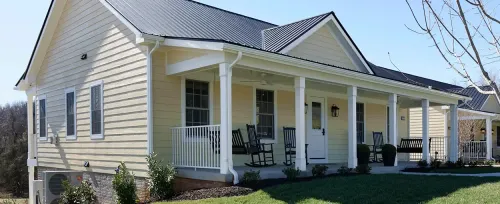Challenge: Finding non-traditional ways to build an end-to-end, energy efficient, and sustainable home.
Solution: PUMY heat pump zoning system and integrated controls from Mitsubishi Electric, along with various eco-friendly components.
Result: Recently named a LEED® Homes Award winner, the RIFT House raises the bar on sustainability and is an exquisite example of efficiency and environmental mindfulness.
Outside of fast-growing Albuquerque N.M., in the small, rural village of Corrales, the picturesque landscape meets sustainable living at the RIFT House - standing for Regenerative Ingenuity for Tomorrow.
Homeowners Hal and Kyrie Stillman poured their hearts, souls, and experience into imagining and designing a home that delivered a perfect blend of personal comfort, a close connection with nature, and maximum energy efficiency.
They wanted a building that pushed the sustainability envelope and asked the architect, builder, and contractors to think differently, a difficult yet worthwhile endeavor.
Well worth the wait and the effort, the Stillmans were rewarded with a stunning five-bedroom, four-bathroom, 3,800-square-foot home that prioritizes reimagining space and strikes a balance between industrial beauty and eco-conscious living. Their comfortable, Pueblo-style home has been awarded the LEED Homes Award for Outstanding Single Family Home for Single Family Projects.
A Gorgeous Home With Little Environmental Impact
All the mechanical systems, refrigerant lines, and ductwork are exposed because the Stillmans didn’t hide anything behind the walls. This was purposeful, reducing building costs since there is no drywall and structural 2x4s needed to cover the equipment. Hal also believes people should see and know how their homes work.
Kyrie, who has a marketing and business background, and Hal, who has a mechanical engineering and business background, call the ductwork, electrical lines, and other exposed utilities the jewelry of the house.
“When people enter the RIFT House, they’re blown away by how beautiful the installation is,” said Kyrie.
Kyrie and Hal made thoughtful choices with building materials, and incorporated an energy recovery ventilator (ERV), a feature the Stillmans think should be mandatory in new home builds. The ERV has helped the couple greatly reduce the presence of volatile organic compounds (VOCs) that can potentially make people sick. In fact, the all-climate heat pumps, which work in searing heat and extreme cold environments, also ensure the house is dust-free.
An ERV can help reduce toxins, odors, and other contaminants by exhausting them to the outside while diluting them with incoming fresh air.
A Fan Of METUS Heat Pumps
Although RIFT House is their first new build, the Stillmans have renovated several homes and have used a variety of HVAC systems. They first used a Mitsubishi Electric Trane HVAC US (METUS) heat pump system in 1986 when excavating a room under an existing house.
“I wanted accurate temperature control for heating and cooling, and it worked great,” said Hal.
They outfitted another rehabilitated house in Seattle with a METUS heat pump system and were happy with the results. When it came to an HVAC solution for the RIFT House, the couple chose a ducted PUMY system and seven indoor fan coil units (a multi-zone system with individual room controls).
PUMY heat pump systems are designed to deliver operational cost savings and are ideal for efficiency ratings and Energy STAR® qualification.
“Outfit your home with an all-electric heat pump. In doing so, you are reducing your carbon footprint and saving a lot of energy,” said Hal, who’s been involved in energy efficiency and electrification for more than 30 years. “There’s no other choice in my mind, especially since we’ve saved so much money.”
Floor-To-Ceiling Eco-Friendly Components
During the build, Kyrie put an enormous amount of effort into sourcing sustainable materials. For instance, the tiles, quartz countertops, powder-coated MDF cabinetry, and window shades are comprised of a minimum 87% recycled or recovered material.
All these components and more met LEED Platinum rating percentages of pre-consumer waste. The Stillmans also chose to source as much of the materials as they could from within a 500-mile radius to minimize carbon emissions from transportation. The triple-paned windows, for example, were purchased from Colorado-based Alpen High Performance Products, which proved to be cheaper and better performing than the doublepane options they considered.
The walls have R35 insulation, a Styrofoam material containing graphite that effectively slows the transfer of heat energy. It is lightweight, easy to install, and cost-effective. Plus, the home is outfitted with a 38-panel solar system that generates 21 megawatt (MW) hours of power.
Sustainable Buidling Is The Right Thing To Do
The RIFT House build was challenging, from concept to design to sourcing eco-friendly materials to being awarded the Platinum LEED certification. However, it was well worth the challenge since the Stillmans are adamant about improving the world their grandchildren will grow up in.
“We could have taken an easy path by building a traditional New Mexico-style home but chose not to. We chose to go to the moon, not because it’s easy but because it’s hard but worthwhile,” said Hal, giving a nod to John F. Kennedy’s “We Choose to Go to the Moon” address at Rice University on Sept. 12, 1962.
Building an eco-conscious home is attainable and well worth the effort, and the Stillmans have proven that sustainability is not only doable but beautiful.
Click here to watch the RIFT House video series.
Mitsubishi Electric Equipment
- (1) PUMY-P60NKMU3 Outdoor Unit
- (4) PEFY-P06NMAU-E3 Indoor Unit
- (2) PEFY-P08NMLU-E3 Indoor Unit
- (1) PEFY-P18NMAU-E3 Indoor Unit
- (1) AE-200 Controller
- (7) MHK2 Controllers
Project Team
Architect: Equiterra Regenerative Design
Home Builder: Sun Mountain Construction, Inc.
Engineer: Installation Service Heating Cooling (ISHC)
HVAC: Installation Service Heating Cooling (ISHC)










